The DaimlerChrysler era of Chrysler history is not one in which enthusiasts look back with fondness. Cars built by Chrysler and its brands back then were known for their hard plastic interiors, aggressive cost-cutting, and bizarre design decisions. But not all of its products were like this. One was so good it came perhaps a decade or two too early. That car was the original Chrysler Pacifica. This tech-heavy crossover was supposed to usher in a luxury rebranding for Chrysler and totally failed at the job. Yet, despite what you might have heard back then and even today, the Pacifica is actually cooler than you might think.
Back in May 1998, Chrysler and Daimler-Benz tied the knot, moved in together, and started sleeping in the same bed. The new DaimlerChrysler was hailed as a “merger of equals” that painted the married brands as titans that were going to benefit each other. On paper, DaimlerChrysler seemed like a great idea. One of the main benefits of the merger was that Chrysler would lend its expertise in mass-market automobile manufacturing while Mercedes-Benz would offer its cutting-edge technology and refined luxury. Together, this was supposed to lead to higher quality and more luxurious mass-market cars, benefiting everyone involved.
In practice, the DaimlerChrysler era was a disaster of comedic proportions. As David Tracy explained last year, practices like Material Cost Management had Chrysler cutting costs way too far, leading to those grungy, infamous interiors. Meanwhile, the culture at DaimlerChrysler left many feeling like Daimler was sucking Chrysler dry to keep itself afloat.
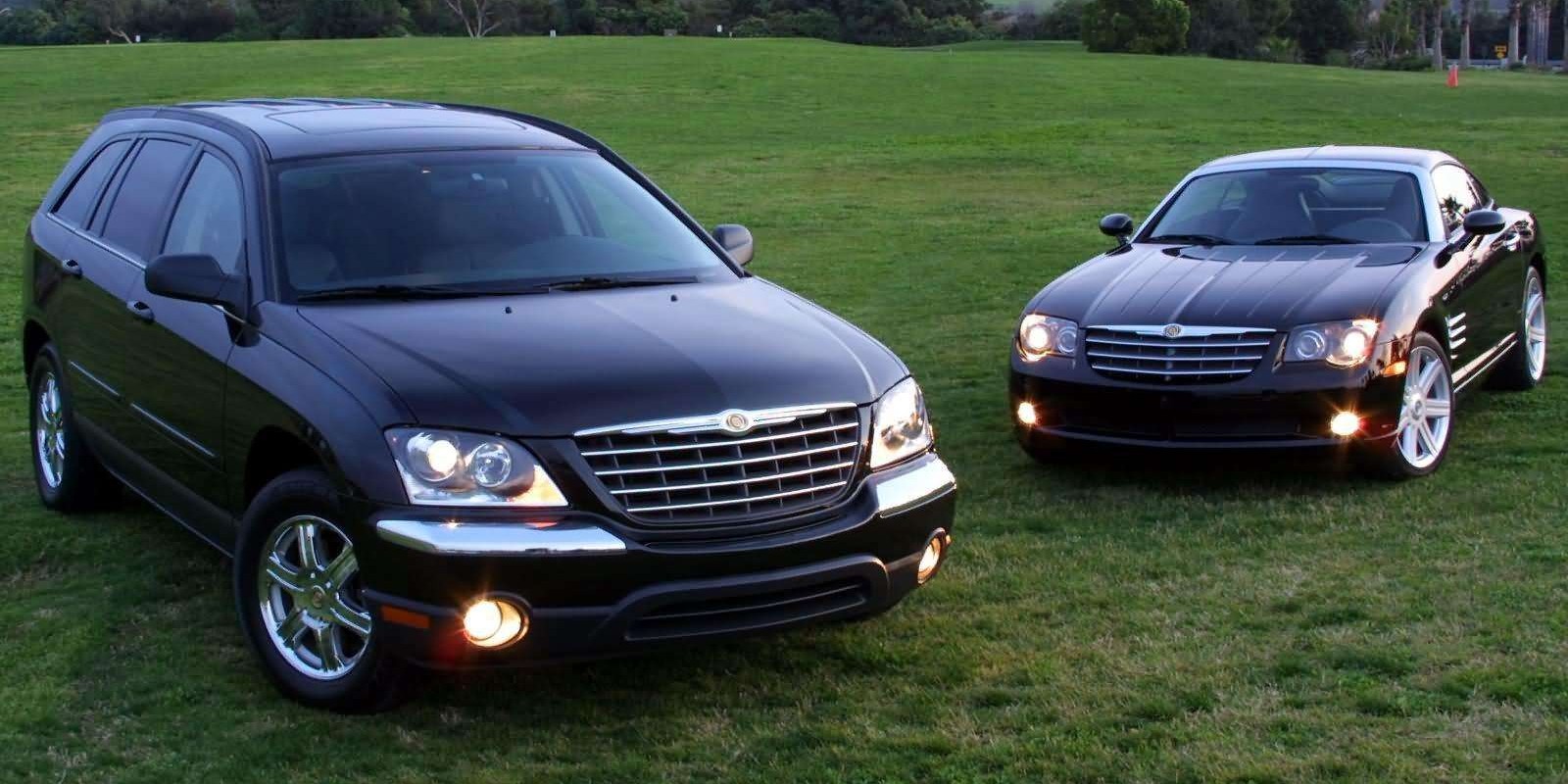
Harvard Business Review suggests that the whole deal just sort of sucked for everyone:
In theory, the Daimler-Chrysler combination should have yielded two very potent sources of competitive advantage. The first was a cohesive global brand architecture. Consider Toyota. Its brand structure is extremely clear and logical: Lexus for the high-end buyer, Toyota for the middle-income family, and Scion for the hip young. The segmentation makes sense and the progressions between segments are natural ones. Young people find partners, have children, and buy minivans; people with money move up to luxury vehicles.
The second potential source of competitive advantage lay in creating a coherent platform strategy built on the economic logic of parts sharing. Because the cost of developing new vehicles is so great, car companies design “platforms” from which they create families of vehicles. They also try to share parts between platforms to drive economies of scale in manufacturing. See two papers on the history of the US and European automobile industries and platform strategy — 1, 2 — that I wrote with Nathan Simon.
Realizing synergy in brand architecture and platform strategy would have required deep integration of Daimler and Chrysler. German engineers would have had to design cars using parts created by American engineers and vice versa. The management team would have had to develop a global brand strategy and associated logic of competitive positioning. None of this happened. They ran the two organizations as separate operations. When major shifts in the environment (rising gas prices and the move away from SUVs and trucks) kicked out the blocks from under Chrysler’s recovery, it was both necessary and possible for them to part.
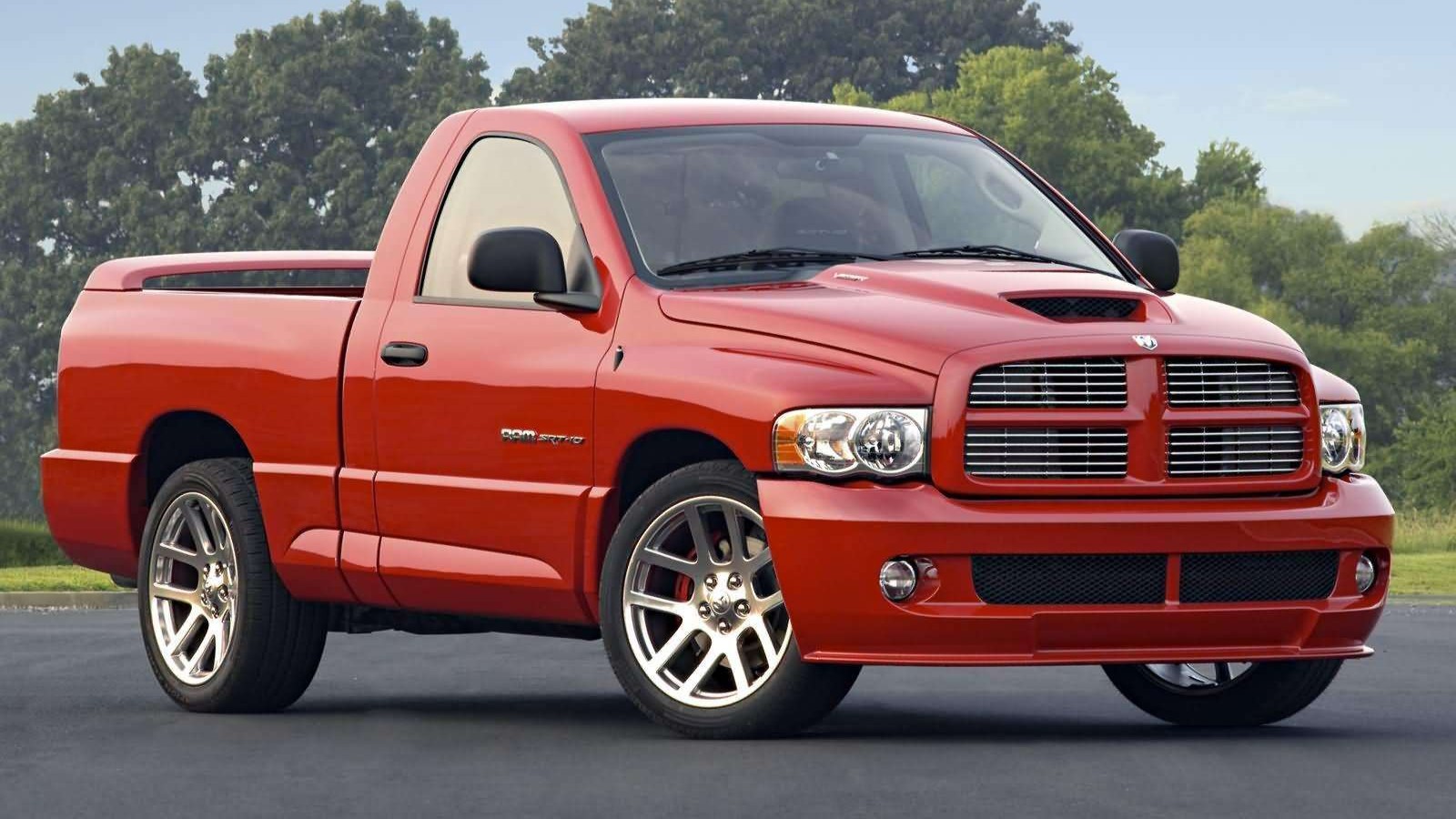
Daimler chairman Jürgen Schrempp called the merger a “marriage made in heaven.” It wasn’t, but not everything was bad! The DaimlerChrysler era created the epic Viper-powered Dodge Ram 1500 SRT-10. It also gave us the beloved Chrysler LX platform, which had pieces of German flair under its skin.
The Chrysler Pacifica and the Chrysler Crossfire were intended to be demonstrations of the benefits of DaimlerChrysler. Buyers would get to enjoy a vehicle with the best that both Chrysler and Mercedes-Benz could offer in one package.
Today, it might be hard to look back at the Pacifica with a positive view. It doesn’t help that so many of the Pacificas that remain on the road today have gaping rust holes, missing panels, and the headlight equivalent of cataracts. These things have been beaten up so badly and depreciated so far that it’s not even that hard to find a running example for $1,500.
The Pacifica was thought to be destined for something greater. This was the car that was supposed to lead Chrysler into an era of American luxury. It didn’t, but maybe that doesn’t make the Pacifica so bad.
Chrysler And Mercedes Get Weird
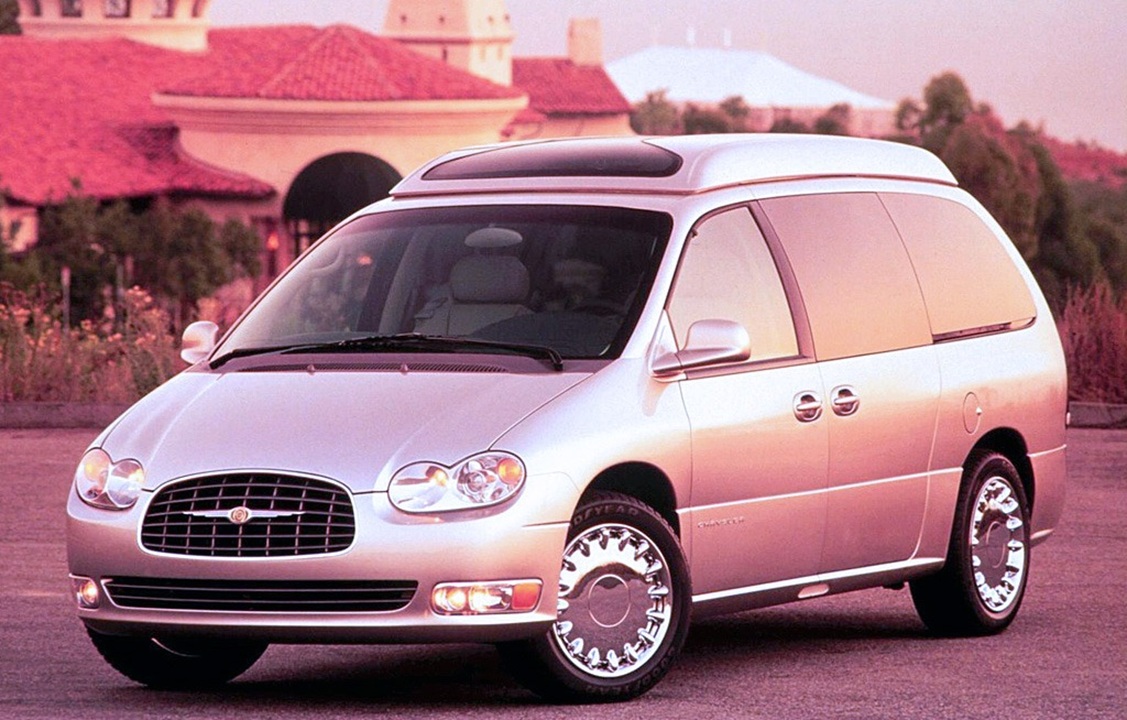
In 2003, Autoweek reported that the Pacifica’s development traced back to Auburn Hills in early 1999. DaimlerChrysler was riding high on the explosive interest in the Chrysler PT Cruiser. Meanwhile, Chrysler’s minivans were still flying off dealership lots. Even stock traders got in on the frenzy, pushing DCX above $100. It really seemed like this merger thing was off to a great start.
Under the hood, however, was some of the chaos that I mentioned later. The Germans in Stuttgart and the Americans in Michigan now had to figure out how to meld each other’s cultures and technologies to create the next big thing. SUVs had proven themselves to be winners in the marketplace. Meanwhile, a new contender had entered the ring in the form of the crossover. Many automakers had begun to learn the same thing: that moving forward meant investing in large vehicles. Autoweek continues:
Well before the merger was complete, planners from both companies had peeked at each other’s product portfolios, with each partner discovering that the other side had similar designs on the sports tourer of the future. After the merger, the most cost-effective route may have been to build two different wagons—Pacifica and [Grand Sports Tourer]—off one strong platform. But the idea of a budget Chrysler badge adorning Mercedes hardware, or worse yet, a Mercedes marque appearing on a mere Chrysler, was far more than the German end of DaimlerChrysler was ready to accept—at least publicly.
Even after Chrysler and Mercedes revealed their surprisingly similar sports tourer concepts at the 2002 Detroit auto show, both sides continued to deny any product development collusion, and to this day claim that both vehicles were developed independently.
While that technically may be the case, the seeds of sharing were sown in the early stages of GST development when the Germans, uncertain how to proceed with their next product for the North American marketplace, reached out for guidance from Chrysler in what was likely one of the first concrete steps toward taking advantage of the engineering, product development and marketing strengths inherent in the partnership.
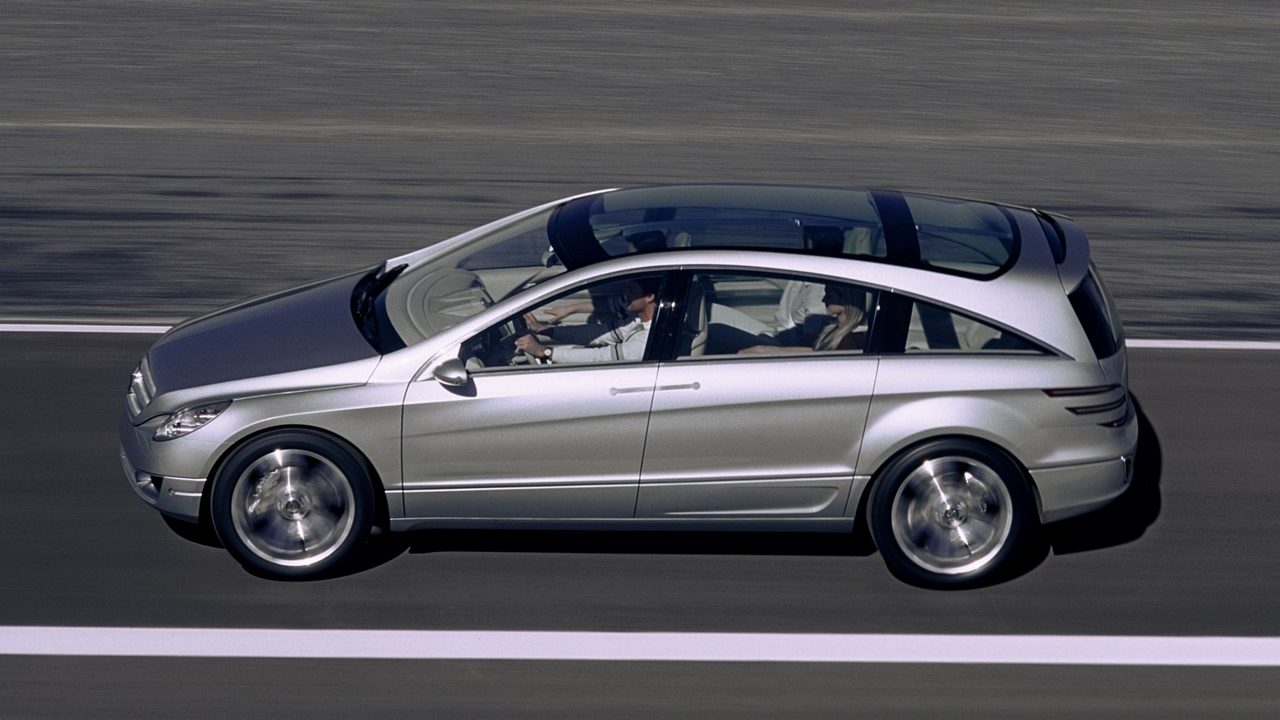
As Autoweek notes, Mercedes-Benz had its M-Class SUV in America, which turned out to be a success. Naturally, the Germans wanted to follow the sport utility up, but Germany is an ocean away from America. How would the engineers in Stuttgart know what to design for Americans? Well, they got an American, of course! Mercedes-Benz reached out to Chrysler for help, and mechanical engineer Mike Donoughe rose to the task.
Donoughe had a pretty great record at Chrysler, with 16 years at the company working on projects like the powertrains for Chrysler’s cloud cars (the Chrysler Cirrus, Dodge Stratus, and Plymouth Breeze). In Germany, he’d help lead the way for the sequel to the Mercedes-Benz M-Class. This was the Grand Sports Tourer, or GST, which would go into production as the glorious R-Class.
Over in America, Chrysler design director Joe Dehner led the team behind what would become the Pacifica. Both teams had come to the same conclusion that while minivans were popular, the next big thing was the sports tourer of the future.
Chasing Trends
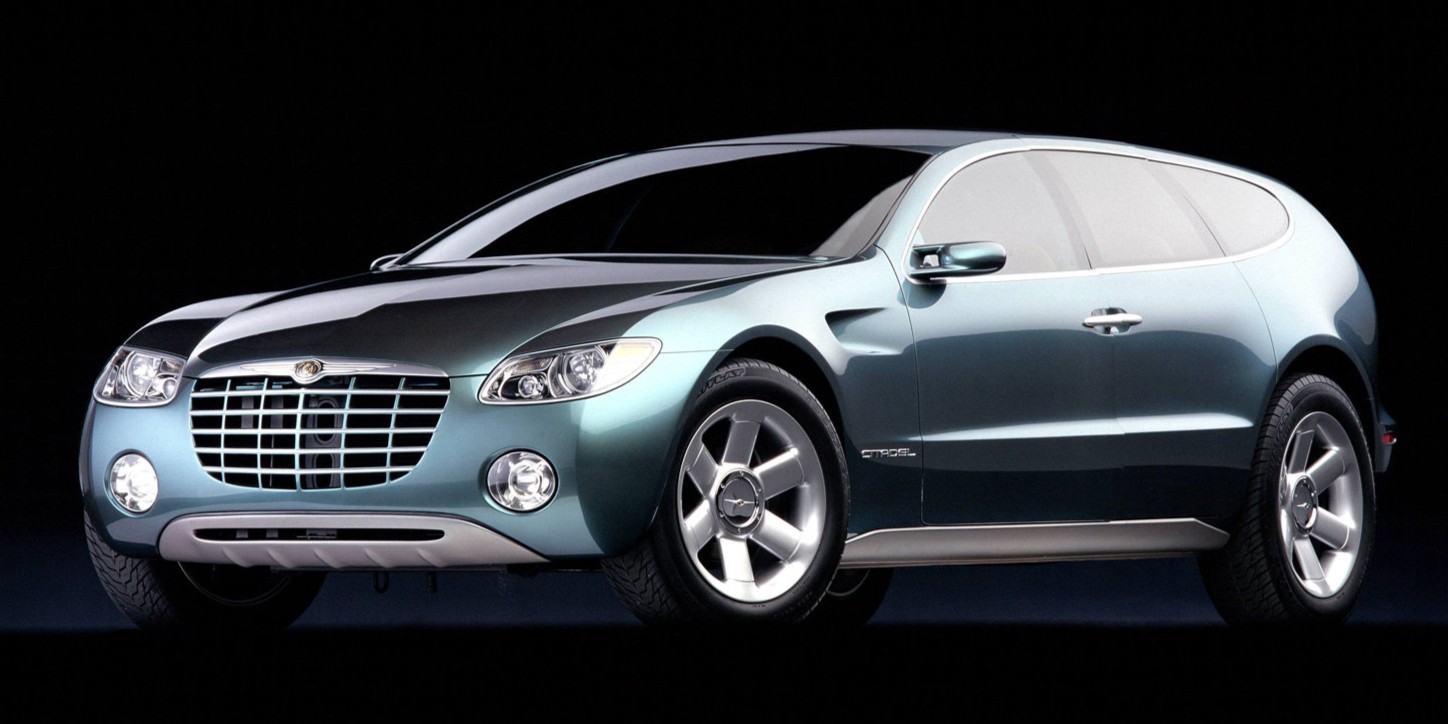
Now, if you look at the R-Class and Pacifica next to each other, I wouldn’t fault you for assuming that the Pacifica was an R-Class in a cheaper suit. Both sort of look like minivans without sliding doors, and both leaned hard on the idea of being a multipurpose, multi-category vehicle. But this wasn’t the case. The R-Class and the Pacifica ride on two entirely different platforms and, as Autoweek notes, do not share parts. The two teams might have compared notes, but these are not at all the same vehicle.
You might also find it hard to put a finger on what, exactly, the Chrysler Pacifica is supposed to be. This is because it’s trying to be multiple vehicles in one. Autoweek noted that Chrysler’s team knew what it wanted in its sports tourer. The vehicle would be tall and have the stout appearance of an SUV. At the same time, the team wanted this vehicle to swallow people and cargo like a minivan, but handle like a car.
That last demand dictated what the new vehicle would ride on. Body-on-frame platforms back then were rugged, but not exactly graceful in the corners. As Autoweek wrote, Chrysler’s solution was to borrow its unibody minivan platform. Reportedly, one of the first prototypes was little more than a minivan with a chop-top roof and standard car rear doors. This prototype had the beltline of an SUV, but it was concluded that this looked too much like a minivan.
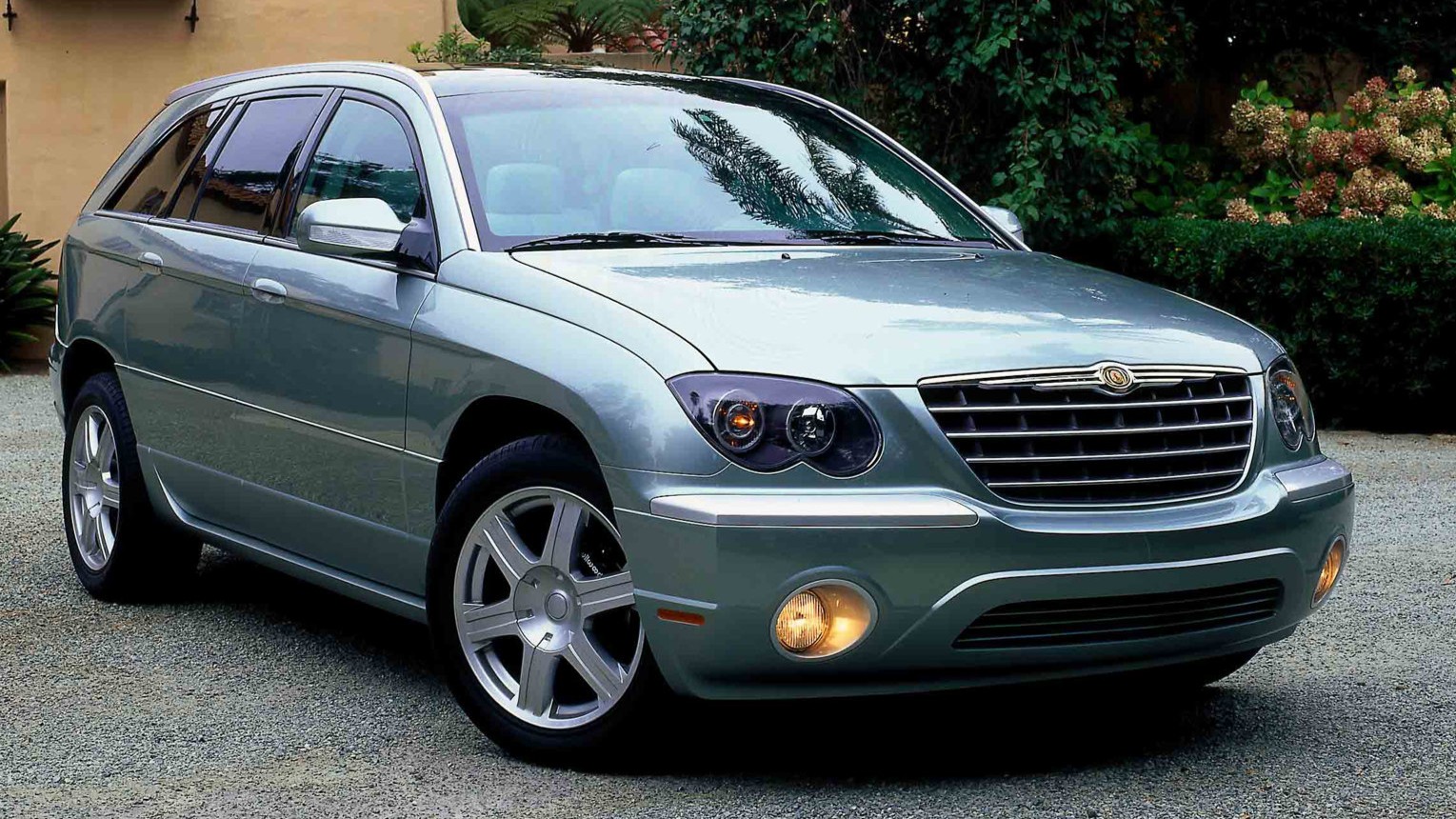
Next, the designers went the other direction, instead building a jacked-up wagon on Chrysler’s LH platform. Unfortunately, this didn’t have the burly SUV aesthetic that the team had been looking for.
Autoweek notes that this led the development team to a conclusion. They couldn’t just modify an existing vehicle to get what they wanted. Instead, they’d take the minivan platform and use it to create something new. This, Autoweek notes, is how Chrysler used the Neon’s platform to design the PT Cruiser.
This time, Chrysler’s team got what they wanted: a large three-row vehicle with the presence of an SUV, the practicality of a minivan, and the dynamics of a wagon. But this was only half of the Pacifica equation.
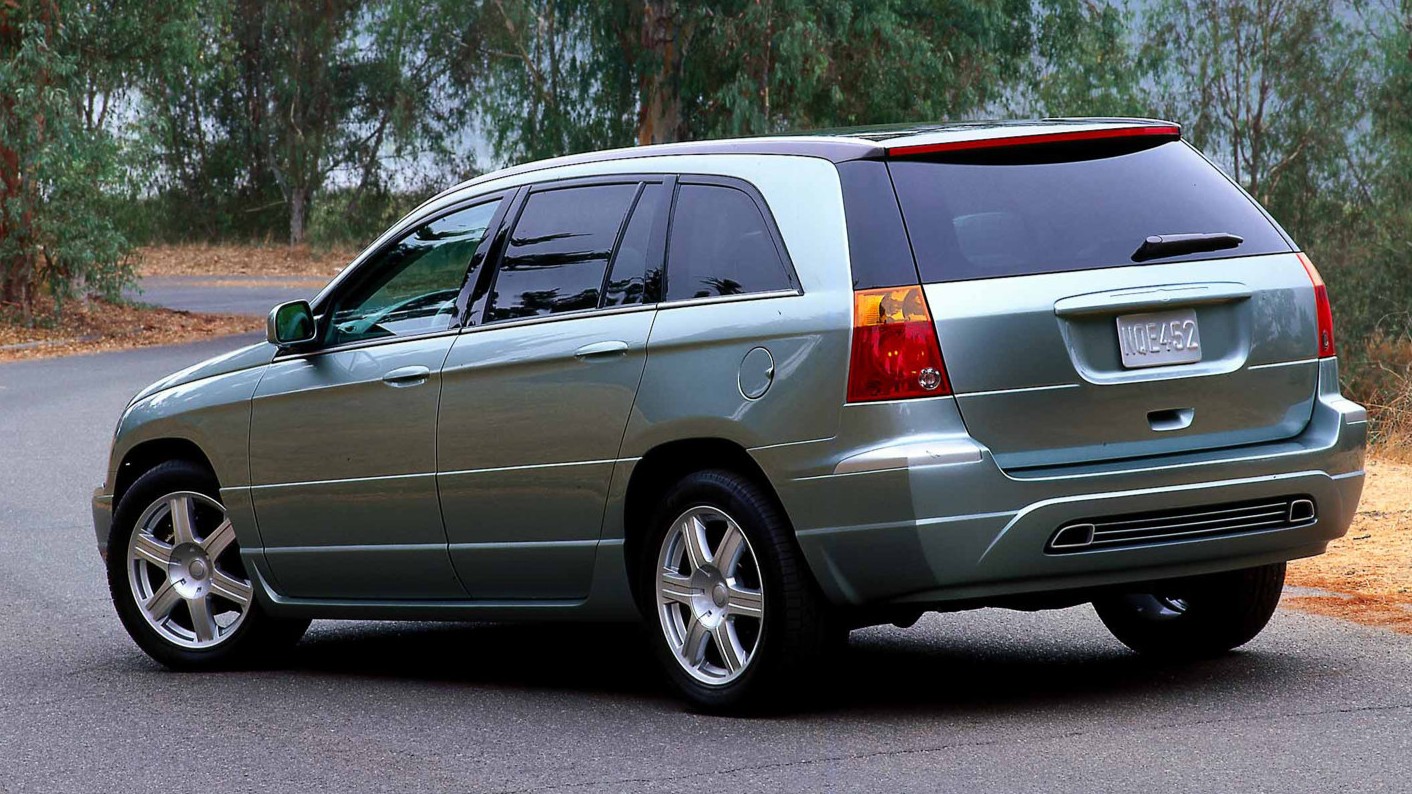
Autoweek notes that by 2002, the temperature in the room was pretty hot as some had already felt that Chrysler and Daimler hadn’t merged so much as the latter took over the former. Chairman Jürgen Schrempp replaced himself with Dieter Zetsche in an attempt to bring down the temps. One of the biggest changes new management brought was allowing Chrysler to raid the Mercedes-Benz parts bin while also giving the Chrysler team additional access to Daimler’s vast resources. Autoweek continues:
“I really understand the market for both vehicles,” Donoughe notes. He brings a slew of intangibles back to Auburn Hills, including a direct link to engineers on the GST project whom he doesn’t hesitate to call on for assistance with Pacifica. A direct beneficiary is Pacifica’s chassis, which is tuned in a driving simulator in Berlin that Donoughe used during his Mercedes tour. The six-month process results in a unique front suspension and—gasp!—a five-link rear suspension borrowed directly from the Mercedes’ E-Class and modified for the Pacifica. Interior refinement also gets a boost from Mercedes, from the company’s trademark, intuitive door panel-mounted power seat, pedal and steering wheel adjustments, to the quality and refinement of materials. Donoughe’s Teutonically tuned sense of precision and detail leads to other changes, not the least of which is his demand for a quieter analog clock when, during a test drive, he traces a recurring instrument panel clicking sound to the minute-by-minute movement of the clock’s big hand.
A Minivan, Wagon, And SUV In One
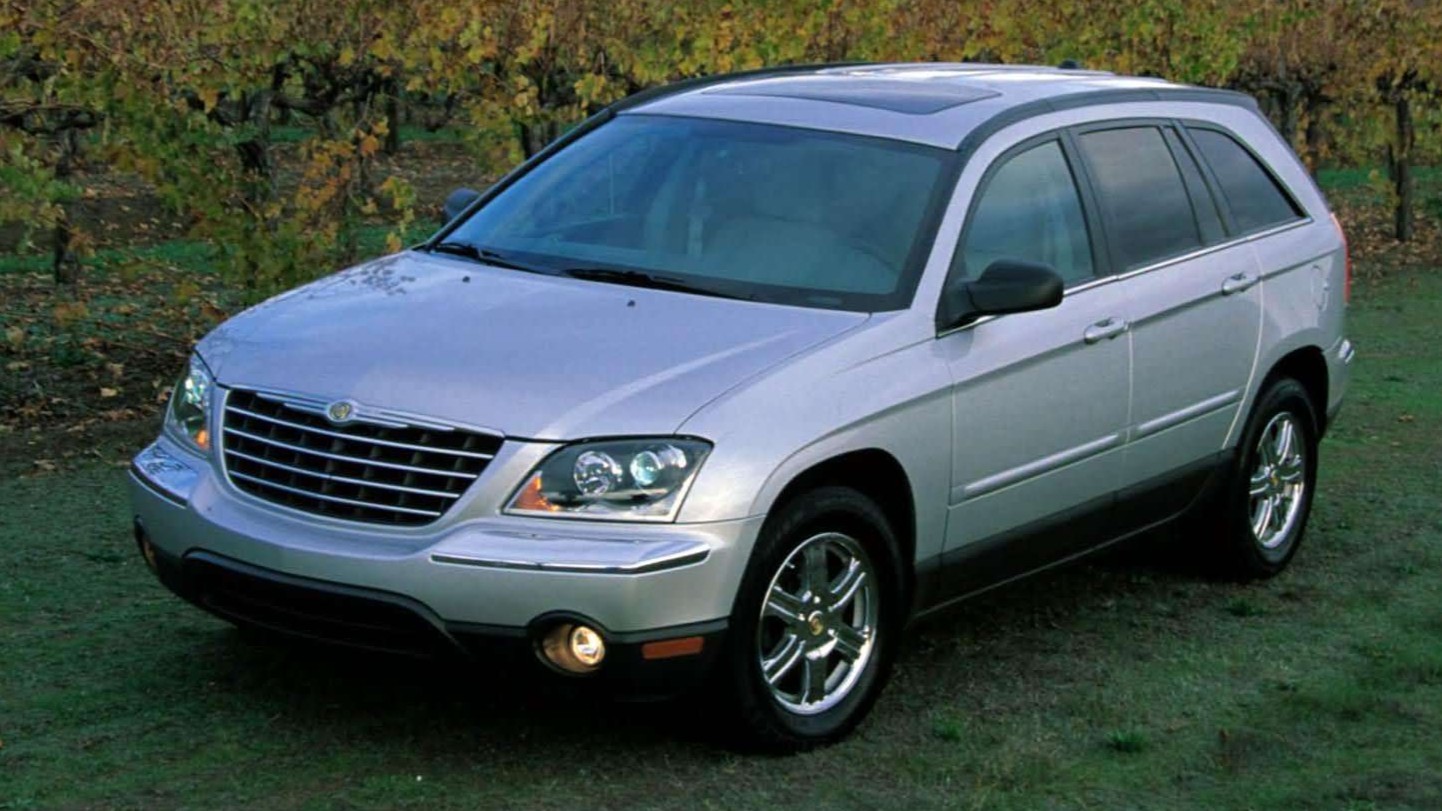
The Pacifica would go on sale in early 2003 as a 2004 model. The first Pacificas shot for the stars. Available features included first and second row heated leather seats, laminated glass, a 10-way power driver seat, dual-zone climate control, a power sunroof, a navigation screen in the instrument cluster, a power tailgate, a DVD player, satellite radio, 5.1 surround sound, tire pressure monitoring, and so much more. These were huge for a Chrysler back then. This thing even had power-adjustable pedals with a memory function, something that Chrysler said was the first in the industry.
The Pacifica also rode on a pretty smart platform. Power came from a 3.5-liter 24-valve V6 building 250 horsepower and 250 lb-ft of torque, which was bolted to a four-speed automatic with a manual shift function. A five-link suspension with load leveling and height control took care of suspension duties in the rear, while struts handled the front. The Pacifica had a base price of $28,845 in 2003, or a minimum of $32,300 with AWD. Pile on the long list of options, and you were knocking on the door of $40,000, or big money for a Chrysler back then.
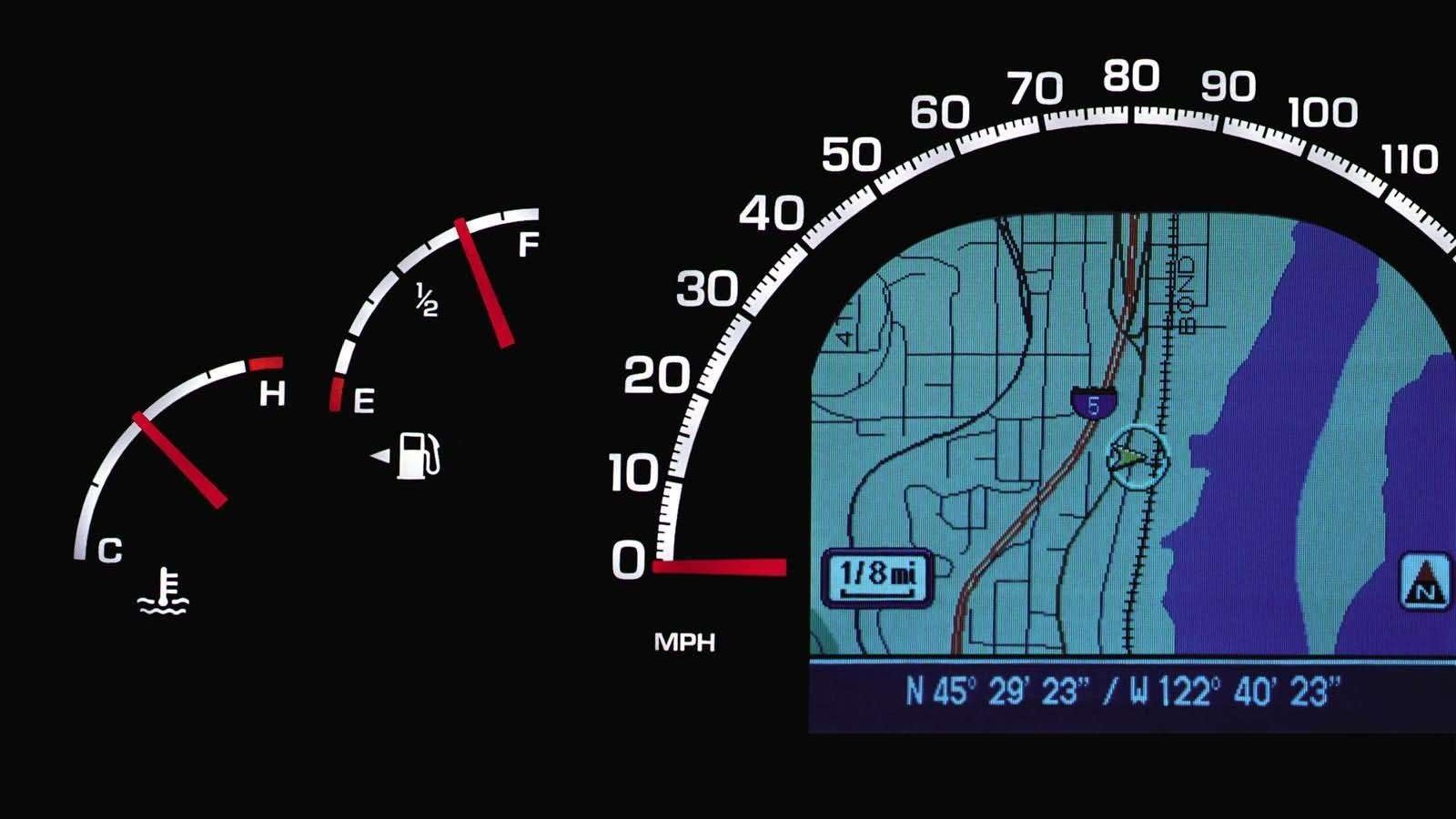
All of this was huge. Also massive was the cost. Chrysler said that it spent 30 months and under $1 billion developing the Pacifica. This investment was only the beginning, as Chrysler saw itself moving upmarket into luxury territory. Chrysler saw itself as being successful here, too, projecting sales of 100,000 units per year for the Pacifica.
This was ambitious. Remember that, at that point in time, Chrysler had been slinging cars like the Sebring, PT Cruiser, and Voyager, and had rides like the cloud cars and the Neon in its past. These cars were perfectly fine, great even, but luxurious they were not. Chrysler had built itself a reputation for selling affordable trendy cars. Now, it wanted you to think it was going to be one of the next big things in luxury.
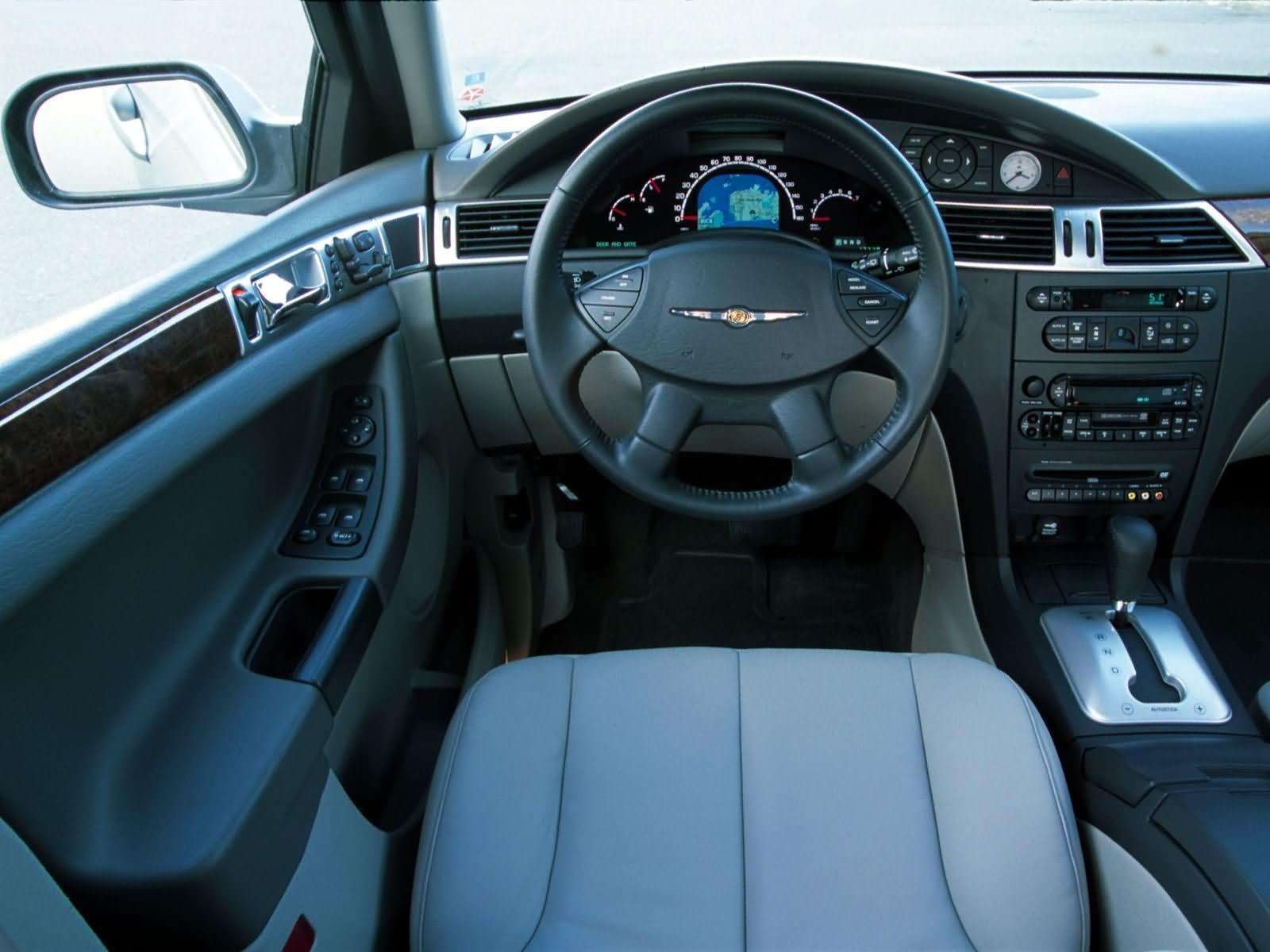
Chrysler knew this was going to be an uphill battle. Thus, in 2003, Chrysler spent a reported $14 million signing a contract with superstar Celine Dion to help Chrysler push its image upmarket.
Unfortunately, in classic DaimlerChrysler style, the Pacifica journey was filled with missteps. One was that, for whatever reason, Chrysler never touted the Pacifica as having Mercedes-Benz technology. If you go through the 2004 Pacifica’s 11-page press release, you will find no mention of Mercedes-Benz at all and only a passing mention of Daimler. It’s the same deal in releases archived at Stellantis. One Internet rumor is that DaimlerChrysler didn’t let Chrysler tout the Mercedes tech of the Pacifica for fear that buyers would run to a dealer to buy a cheaper Pacifica than buy a Mercedes. I’ve found no confirmation of this.
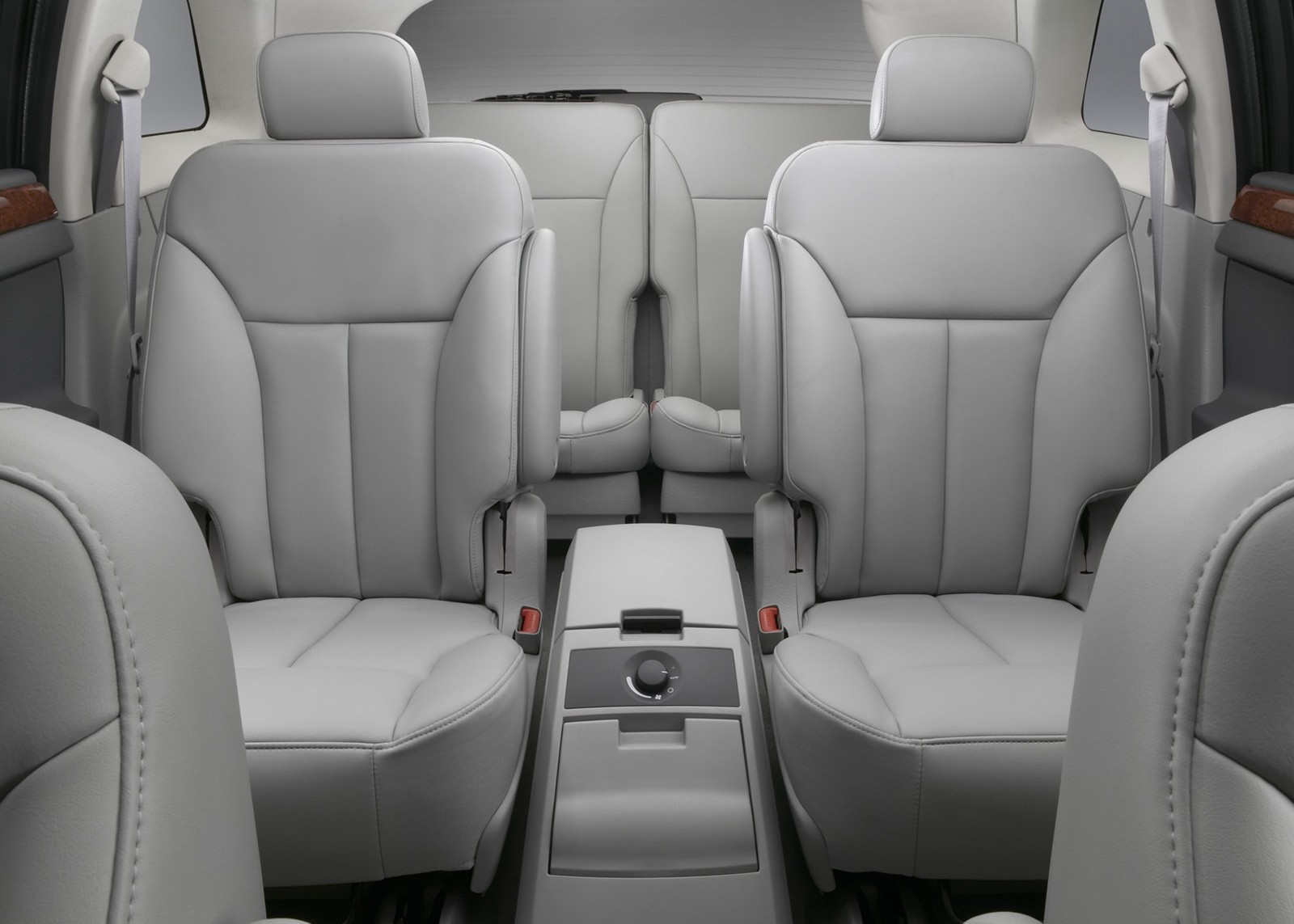
Still, it probably didn’t help. The campaign with Celine Dion reportedly didn’t help, either. According to one report from Autoweek, dealers thought the Celine Dion Pacifica advertisements did more to sell her brand than Chrysler. The automaker abandoned its relationship with the singer only a year into the contract.
Reportedly, Chrysler’s own ad agency warned the automaker not to partner with Celine Dion in the first place. Chrysler wanted affluent young people to buy a Pacifica, but Dion was much more popular with an older audience. Focus groups had suggested that Dion had the most pull with people aged around 52. Perhaps it wasn’t a surprise to anyone, then, that the average age of a Pacifica owner was 53. Oops. At least the ads looked neat:
The Pacifica’s sales never came close to meeting expectations. Only 56,656 examples were sold in 2003, followed by 92,363 in 2004. That year was the closest Chrysler ever came to meeting its goal. Every other year was far south of this. Early on, the vehicle’s high price compared to other Chrysler products and the botched marketing campaign were blamed for the slow sales.
The Press Was Impressed
The press largely had compliments for the Pacifica, but did expose a couple of issues. Car and Driver had mostly good things to say:
Our test car had comfortable leather seats that seemed an appropriate match for the lavish interior design that combines realistic faux-wood panels with silver-colored trim and high-quality moldings. Our vehicle also had a navigation system with its display screen in the speedometer face. That, says Chrysler designers, allowed them to design a conventional console without having to accommodate a large screen that is a blank waste of space when not in use.
[…]
That’s all well and good, but C/D readers are more interested in performance and driving pleasure. In that respect, the Pacifica ought not to disappoint anyone whose priorities drove him or her to a big people mover. Its acceleration times are roughly the same as those of the Lincoln Navigator and not much slower than those of a 3.0-liter BMW X5. Furthermore, the 3.5-liter V-6 seems more than adequate in the cut and thrust of rush hour, even if its high-rpm endeavors occasionally sound a bit labored.
Although the test numbers appear adequate–they’d probably be better in a front-wheel-drive model–it’s obvious that a fully laden Pacifica AWD will have its work cut out on a mountain pass. There’s only so much 250 horsepower can do with a 4720-pound “sport tourer.” Nonetheless, the standard-equipment AutoStick manumatic brings a touch of sportiness to mountain driving, enabling the driver to hold gears and even add engine braking to the repertoire. When in manual mode, the Pacifica will run to the 6500-rpm redline in the lower two gears and will shift up automatically before hitting the 6800-rpm rev limiter. In third gear, for some reason, the system shifts up at 5500 rpm regardless.
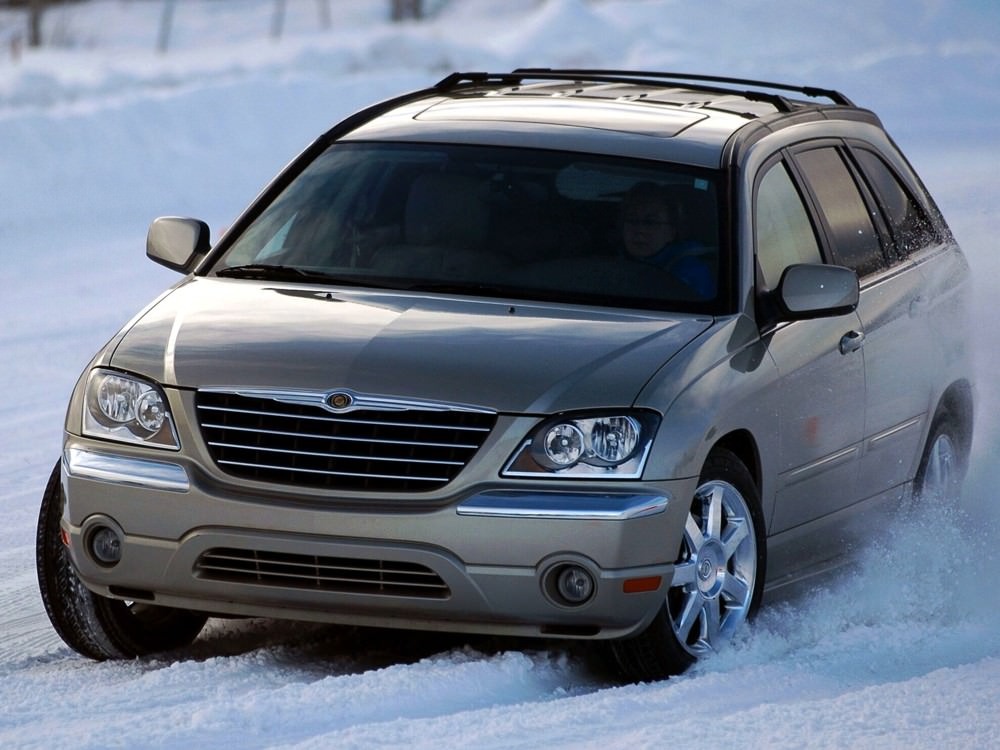
The magazine said the Pacifica handles with “commendable poise” with crisp steering and remarkable urban agility. Car and Driver even went as far as to say, “There’s a real sense of quality in much of what the Pacifica does.” Remember, this was the era of plastic fantastic, so a statement like this is grand.
Car and Driver‘s biggest complaint was with the third row, which it concluded wasn’t really meant for adults. Unfortunately, despite the marketing, the Pacifica wasn’t really minivan practicality and cargo volume with the look of an SUV, but that didn’t seem to matter as much because the press ate it up. The legendary John Davis of MotorWeek seemed to like it, and likened the first two rows to being like flying First Class:
Chrysler made some changes early on, opening the 2005 model year with the LX base model coming in at about $4,000 cheaper. It also got a weaker engine: a 3.8-liter V6 borrowed from Chrysler’s minivans, which made 200 HP and 235 lb-ft of torque. Improvements would come later on in Pacifica production, including the addition of a six-speed automatic transmission and a 4.0-liter V6 that was good for 255 HP and 265 lb-ft of torque.
This wasn’t a huge bump, but did allow the Pacifica to scoot to 60 mph two seconds sooner, which helped to resolve some complaints about the 3.5 V6 being too sluggish.
Sales Didn’t Reach Expectations…
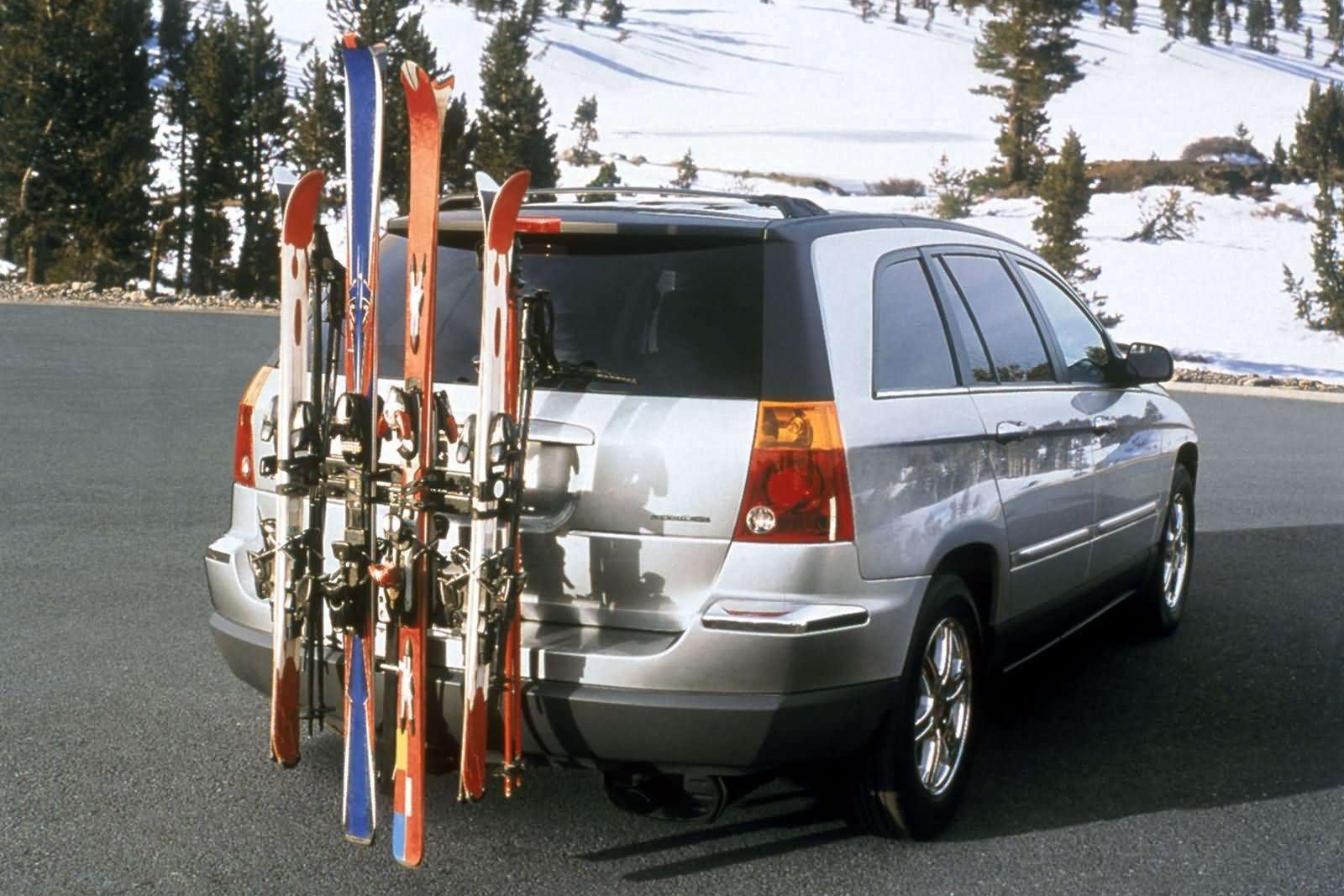
Chrysler would make other changes throughout the Pacifica’s lifespan, but none of them would ever result in sales reaching expectations. The Pacifica would also become known for some quality issues, including interior rattles, electrical glitches, and parts that allegedly fell off. For many, this means that the Pacifica was a flat-out failure. The Truth About Cars wrote an entire rant about the Pacifica’s quality, cramped third row, lack of cargo space, and powertrain. The publication then claimed that Chrysler lost money on every Pacifica sold.
However, I will note that, regardless if Chrysler made money or not, it sold 393,471 Pacificas between its launch in 2003 and its cancellation in 2009. The Pacifica may not have been as popular as Chrysler wanted it to be, but the public obviously liked them. Curbside Classic correctly points out that the Pacifica outsold the Nissan Murano for three years. Meanwhile, the Buick Rendezvous would have killed to have the Pacifica’s sales numbers. Though the Pacifica couldn’t unseat the king, the Lexus RX. Part of that may have been because a loaded Pacifica knocked on the door of the price of a Lexus RX, but Lexus had prestige, and Chrysler didn’t.
…But It’s Still Great
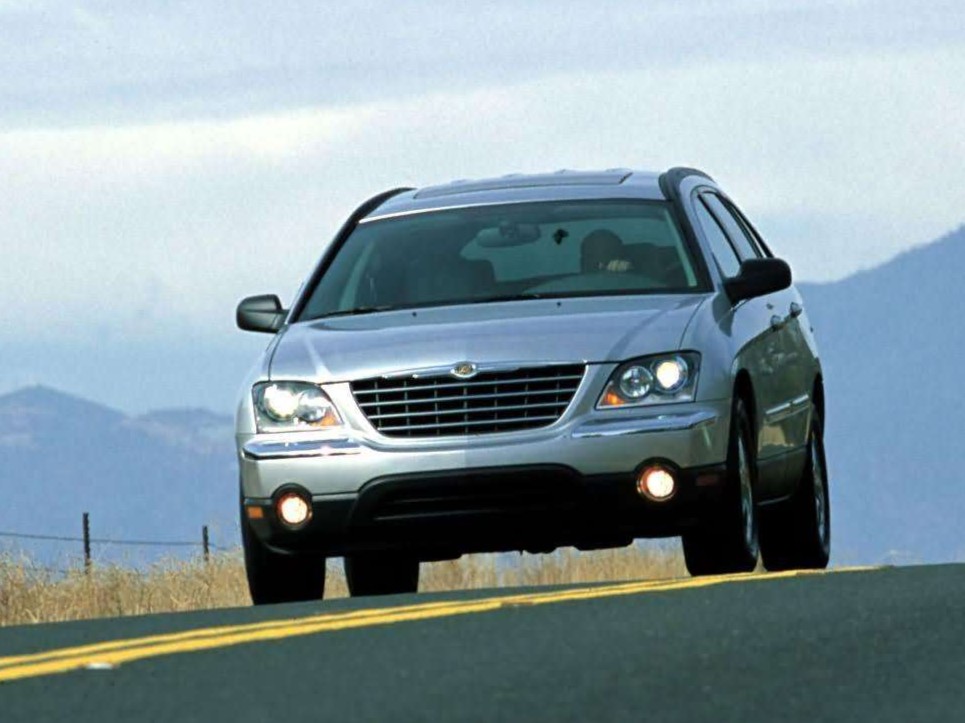
It would be easy to declare the Chrysler Pacifica as an Unholy Fail, and in some ways, the pieces are all there. The Pacifica didn’t meet sales quotas, it was the victim of bungled marketing, and didn’t fully live up to its promises. The vehicle performed so far under expectations that Chrysler never completed that move into the luxury market.
However, I think the Pacifica’s problem was one of timing. Chrysler of the 2000s was known for slinging cars that seemingly had more hard, pebbled plastic than metal. Yet, the Pacifica wasn’t that. I’ve ridden in a Pacifica a few times and it was shocking in how much it wasn’t like other Chrysler products. You really felt and saw the Mercedes-Benz influence in there. It was almost as if there had been an alternate reality Chrysler that was a luxury brand and the Pacifica accidentally leaked out into this universe. Here’s some more Celine Dion:
Chrysler’s brands would straighten up their act a lot during the FCA years. Interiors got much better and the few models that Chrysler had remaining got pretty classy. Now, Chrysler’s brands sell some pretty premium vehicles. I could see something like the Pacifica being in Chrysler’s lineup today. Maybe the Pacifica’s problem was really that it came perhaps a decade or two too soon?
So, I don’t think this really is an Unholy Fail. Instead, I’d call the Pacifica a great, cheap car buy. As I said earlier, you can get one of these for $1,500 if you don’t mind a broken one, and a good one won’t cost you a ton, either. Look at all of those features up there! That’s a lot of bang for not a ton of money. Will it be as reliable as an old Toyota Camry? Probably not. But you’ll probably wow your passengers when they hop into your 2004 Pacifica and get shocked that, yep, this thing is a Chrysler.
I like to think that, in a different world, Chrysler succeeded. The Pacifica, Crossfire, and Celine Dion thrust Chrysler into a premium market. I wonder what its lineup would look like today? I’m not sure, but the Pacifica was a preview for what could have been.
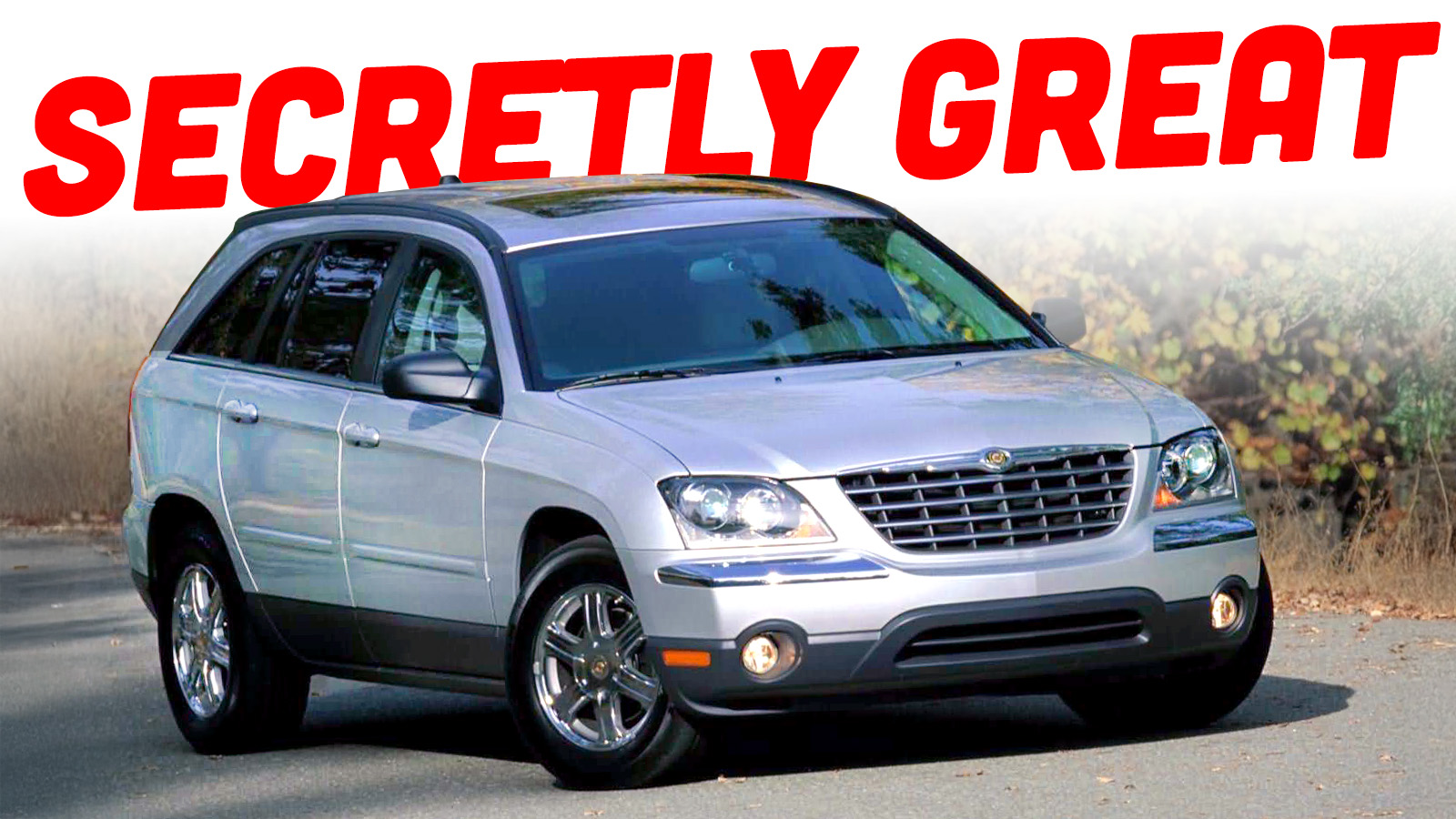



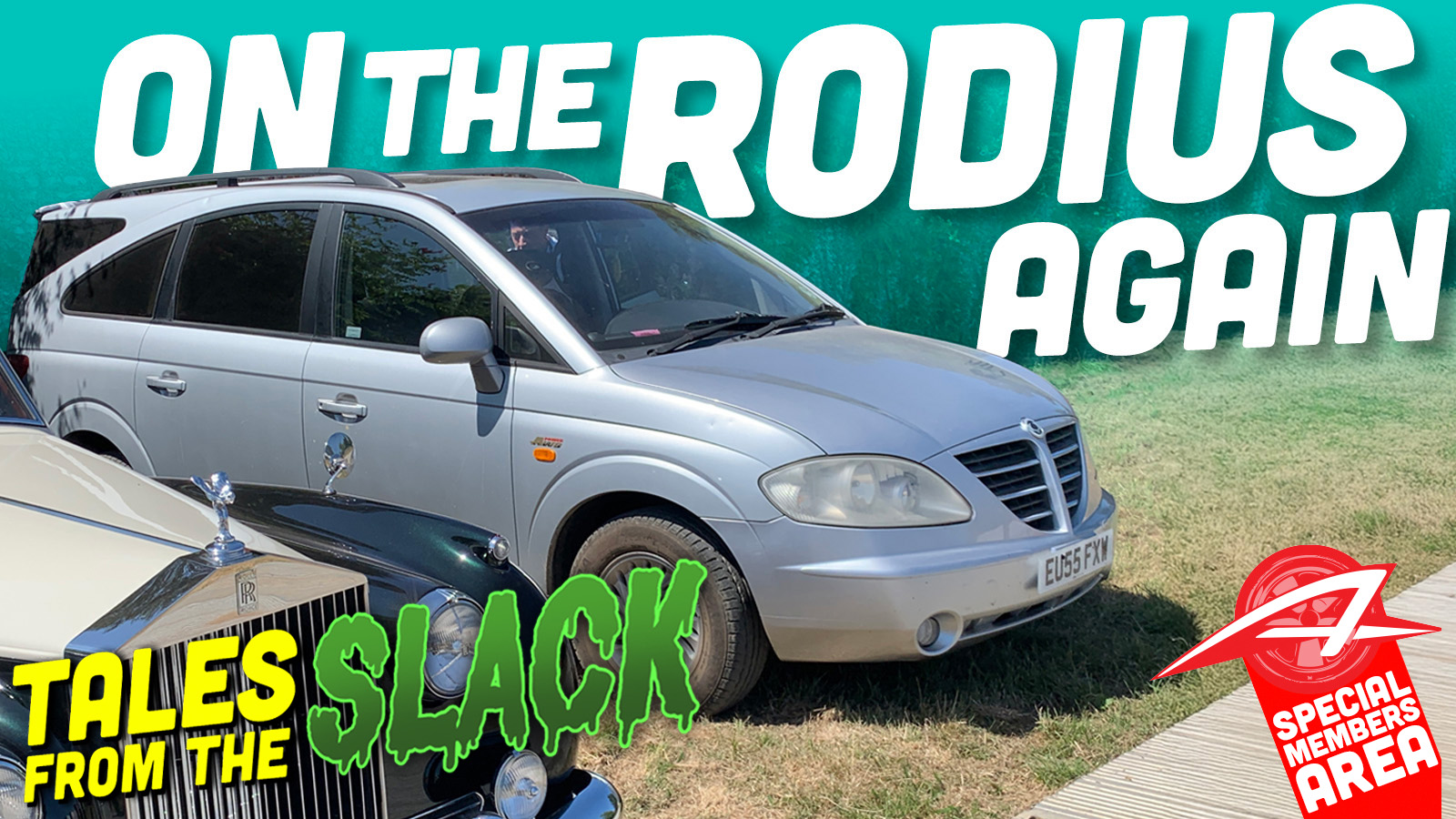

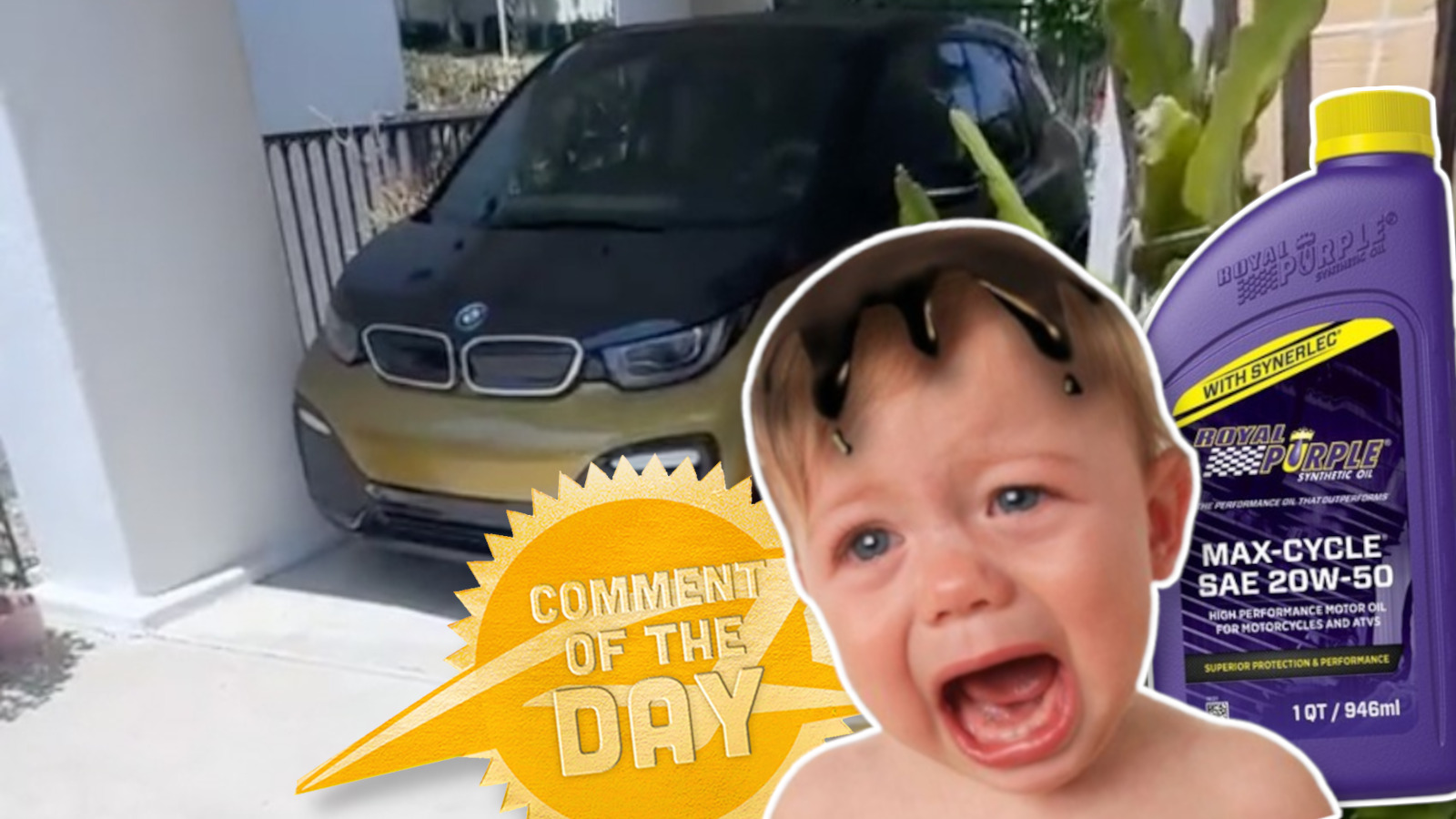
I’ve seen a few Pacificas with weird electrical gremlins. Opening the driver’s door turned on the front passenger corner lamp and turning on the headlights activated the windshield washer type weird. The kind of thing where you really can’t figure out how that could even happen. I’m sure that’s not typical of them but it still made me wary.
Had one of these when I still had a family of 5 with 3 younger kids. It was absolutely great for road tripping with one massive, glaring issue at first – it had 2 saddle tanks in the back for fuel. When the left one drained, there was a pump to move fuel from the right to the left. This pump kept failing. This resulted in having fuel right up until it was half full, then it was effectively empty. You never knew how much you had left, so one fateful trip across country from Cbus, OH to Tucson and back, we had to keep stopping every 140 miles or so for fuel. (Oh, and it got terrible gas mileage with the original 3.5L V6 – the car was simply too heavy with a full load for that lump.) It took like 5 trips to the dealer before they and Chrysler finally figured out the problem.
It was, however, supremely comfortable, full of tech, and the third row was fine for a 7 year old.
Still like the styling of these a lot. Super wide stance, great proportions, and just the right amount of graphic design. With just a couple small tweaks you could still sell this right now. Love the beefy tires, too.
What DiamlerChrysler should have been: ME-412
The DiamlerChrysler we got: Dodge Caliber.
Styling wise, these have aged pretty well. I liked them new, but they still look pretty modern and classy today. Chrysler’s “art deco” era was pretty great from a stylistic stand point.
Agree, but do admit the art deco styling worked best on the Crossfire, ME Four Twelve, this, and 300. On the Seabring, 200, Aspen, T&C, not so much…
Crossfire, ME Four Twelve and 300 were the peak of the design language that all stemmed from the Airflite concept.
300 was great, and I’d argue the Aspen was too (especially compared to that generation Durango).
The Sebring wasn’t bad. It certainly wasn’t as good as the previous ones, but it was a fine (style wise). I think it’s reputation as a POS got tied to the design more than anything. Visually though, I think it beats the competitors from Chevy and Ford.
The T&C was also fine, if not more reserved. I believe it was released as Chrysler was starting to move away from their “art deco” styling, which probably explains why it feels the least “art deco” of those vehicles.
And one more observation…..from the ashes of defeat came another, a refined DaimlerChrysler success story….the WK Grand Cherokee/Durango. Melded Daimler suspension & Chrysler drivetrain(s), combined with good interiors & body structures, the line that started in 2011 continues on even today (scheduled out to 2029), unheard of in this ‘Shiney object of the moment’ auto world….
Was mildly impressed when the Pacifica hit the road, seemed to hit all the right buttons. My first driving experience was during a product launch and a lot of 400 mile trips. I had to duck to miss the A post on every entry/exit, most unexpected & never again. After an all night road trip, fell out of love for the style. Brother in law, though, got the top of the line Walter P Chrysler AWD edition, drove the wheels off it and they loved it well past 200K without fail….
On Good Friday 2004, we traveled to Yuma AZ with our 6 month old child to bury my Blushing Bride’s grandmother next to her grandfather. (Grandma had been cremated; no Weekend at Bernie’s or Aunt Edna strapped to the roof.) *This is important later* We wore our formal dress on the plane, since the graveside service was scheduled for late morning (the pastor warned us that he refused to perform any graveside ceremonies after 11:30 am or 100 degrees, whichever came first) and we could not check into our hotel until 3 pm. We flew into Phoenix and rented a 2004 Chrysler Pacifica. My Father-in-law retired from Chrysler, and we had heard great things about the Pacifica, so we were keen on getting to take the Pacifica on a long-term test drive. Four out of the five of us really enjoyed the trip down I-10 and I-8, because the handling was excellent, the adjustable pedals were really appreciated by the very tall (FIL) and very short (MIL) drivers. it was nicely appointed, and most of us thought the seats were well-suited to long distance travel. Except one of us. Me. Our Kiddo was still in a rear-facing car seat which would not fit into the third row, and the second row seating positions were not optimal for obsessive baby-watching by paranoid first-time parents, so their car seat claimed a second-row spot. The second row seating, sporting three seatbelts, sold the sizzle but not the steak. Instead of two of us being uncomfortably crammed into the second row and unable to launch ourselves into action to address every conceivable need of our darling offspring (the Kiddo slept the whole time; they have always been an intrepid voyager), I volunteered to take the rumble seat. At the time, I was of very average proportions (you, in the back, stop snickering), and I have never been prone to car/sea/motion sickness, so it seemed that occupying the third row was a small sacrifice (it also physically removed me from having to mop up any urp-ups from the Kiddo; they were getting their first test drive as well). We departed from Sky Harbor airport, and by the time we hit Casa Grande, my calves were in need of a stretch, which could only be accomplished by removing a dress shoe. (My professional work attire includes hard-toe boots and other PPE; shiny shoes mean funerals, weddings, graduations, or court appearances.) By Gila Bend, I am not only offering to pay for any speeding tickets that my FIL accrues, I am mentally calculating the amount of cash in my wallet that could be offered to a patrol officer as incentive to provide an “escort” into Yuma. At the graveside service (which my brother and his family also attended, since they lived in Tucson at the time), my brother is holding my leg back to ease the cramping, which ends up ripping the crotch of my suit pants. Loudly. On the return trip, the Blushing Bride and the MIL offer to take the ‘Torquemada Throne’, but I decline, opting to ride in the middle back seat of my brother’s 4 Runner, between my nephew and niece, until Casa Grande. And no, this is not my worst auto travel story.
All this being said, I did get opportunities to drive the Pacifica. I thought it was wonderful, easy to maneuver, if a little wanting in grunt on the hills. This is in comparison to our contemporary 2003 Chrysler Town and Country Limited minivan, which had the pushrod 3.8 V6 and wallowed like a flat-bottomed boat in a hurricane. Despite the third row torture chamber, we were already planning to make a 2008 or 2009 Pacifica our next new car. (I insist on having at least one year free of car payments; makes me feel like I’m getting away with something.) Our friends purchased a 2007 with the 4.0 motor, which we both liked even more (the Blushing Bride has a heavy foot), but we were dismayed when they cancelled the Pacifica before our purchase event horizon. Given the financial crises occurring in 2009, I can understand the objective decision to terminate a marginal product line when sales are slow. However, Chrysler missed yet another opportunity to make a subjective decision. Marketing misfires aside (swing and a miss! This is the first time I have seen either of the Celine commercials; first, Canadian recording artists sell Tim Horton’s, not cars, and second, all you had to do is put Dave Grohl behind the wheel of a Pacifica while “Everlong” plays in the background, and *boom* 150k sales), all Chrysler needed was to release a second generation Pacifica with a 2 inch increase in wheelbase and the Pentastar V6 with the six-speed auto, and they would have been ahead of the curve, and possibly setting the standard, of full-size crossover CUVs. The Pacifica was almost…
I don’t know if it was part of your Vision to reference two more Mopar brand models there, but I had to take the Liberty of pointing it out.
GreatFallsGreen: Oooh, look what you did….I Acclaim your Eagle eyes! Without a Shadow of a doubt, you were Valiant to make the Direct Connection that Dodged me, despite the Neon Arrow Imperially aiming its Dart at my oversight. I have no Fury about not seeing that sly pun on the Horizon. I am not Omnipotent, nor do I seek to be a Challenger, so I offer my congratulations to a Diplomat of your Caliber. Glad to share this Sundance with a kindred Spirit. Oooh, you got me monologuing, you sly dog! (Seriously, thanks for pointing that out! It went completely unnoticed.) As for the rest of you: I would like to apologize from the bottom of my heart for what just happened there, but I won’t. I enjoyed doing it. So there.
Excellent observation. “The Magic Van” says Doug Henning.
Great story.
I had one of these for a while, an ’06 fully-loaded AWD model. The AWD and heft made it great (boring) in the snow. It was one of the most comfortable cars I’ve ever been in (the power adjust pedals were so legit!). But then a plastic tab in the shifter broke and tried to strand me at work. And then the alternator conked out and started leaking alternating current, which fried the ECU and prevented me from smogging it.
It was a horrible, beautiful conundrum of a car. The most comfortable POS. The hated ex that I still think about sometimes.
You said in seven lines what I tried to convey in a thousand words of bloated, overwrought prose, complete with unnecessary Terry Pratchett asides. I loved/hated the Pacifica. It was the automotive version of the ex-girlfriend redhead that threw glass bottles at me, stormed out, and two hours later showed up with groceries to make dinner.
Your story above was immensely intertaining. A genuine thank you, and please keep them coming!
Thank you! The Blushing Bride encourages me to share my anecdotes with a wider audience. This allows her to enjoy her hard-earned decompression time (she is a librarian at a Pre-K through 8th grade school, and we have my 90 year old mother living with us; I have considered creating a gofundme page to cover the costs of lavender bath bombs alone) without feeling obligated to indulge my need to tell my stories. Since she has heard all the old stories, and she has been a star of many of them, I understand her lack of enthusiasm.
If the public liked them, they likely would have continued selling it or not been continually shuffling the lineup around. Pacifica sales actually fell the 2nd full year when they added the cheaper model; I suspect later years were heavier on fleet sales. It may have sold more than the Rendezvous, but the Buick exceeded its sales expectations and was surely cheaper to produce, with more parts shared with the older U-vans. At Nissan, Murano sales were growing year over year.
I don’t think timing alone would have fixed it. It did offer a good amount of space inside, but the packaging seemed to work against it. That cheaper base model was a 5-seater, sacrificing the 2nd row buckets and the 3rd row in favor of a middle bench (like Mazda CX-90 -> CX-70, actually) so there went that benefit. Not that the 3-row configuration was great as the middle buckets had a fixed center rear console, not even a pretense of squeezing into the way back without flipping the seats up or kids walking all over the console. A 2+3+2 layout would’ve at least let them promote it as a 7-seater.
Maybe some timing, actually: by 2004 the Stow’n’Go vans and LX cars were about to hit and Chrysler cared more about those. Perhaps if it had been a year or two earlier they could have tied it into the 300M’s success and recognition – 300M Sports Tourer? 300P to still throw Pacifica in there?
I may have conflated some travel events early in the Kiddo’s life, and I will be the first to admit that my imagination algorithm is adept at inserting “enhanced” data when convenient to further the tale, but I feel sure that our rental 2004 Pacifica had three-abreast second row seating. Perhaps the memory was from another trip that occurred shortly thereafter, involving a rental Dodge Durango with the same miserable third row seating that I recall. Regardless, I stand by my post that the third row was cruel and unusual punishment. No one even took me for ice cream afterwards.
Excellent story! I remember vividly when I saw my first Pacifica when it came out. It was unlike anything else at the time, and I thought it was super cool.
I love that Chrysler paid Celine Dion millions to record a new cover of “I Drove All Night,” and hers is the only major video for that song (the others being by Cyndi Lauper and a post-mortem Roy Orbison) that features no cars and no driving.
My mom adores her ’05 Pacifica. I need to find another one from a state that doesn’t salt the roads because hers is rusting bad enough underneath to send it to the scrap yard, despite the interior and drivetrain being in great shape. It’s bad enough that just jacking it up can be dangerous. But it’s basically her dream car.
You are singing the song of my people. We live in the desert Southwest. Cars don’t rust here, but the arid climate withers and dissolves anything that is not metal. My mother is 90 years old, and at age 88, she chose to stop driving on her own. Our mother has never given anything up without a fight, and she is fully prepared to become diabolically illogical to prevail. (Both my brother and I are Professional Engineers, and our late father was, and I am also a Land Surveyor, all of us Defenders of the Math, so my mother knew that we were powerless in the face of sophistic arguments.) We were gobsmacked that she would relinquish her literal keys to freedom willingly, until she pointed out that my brother was recently retired, and so had “nothing but time” to act as her on-call chauffeur. Our mother has one caveat; that she be driven around in her 1998 Oldsmobile 88 LS. Our late father bought it new (with cash! Depression Era folks, those crazy kids) and my mother got to order it from the factory. The Olds 88 and its H-body cousins are plentiful in Pick-n-pull salvage yards from Cheyenne to El Paso, but everything that started out as dino-juice is functionally useless. Being a car junkie, I have dedicated myself to the preservation of my mother’s beloved 88 (she calls it “Bella Delta”), and I hope that I can keep Bella roadworthy, at least for the sanity of my brother.
The best thing I can say is that its looks definitely nailed the Chrysler ethos. Whether that’s good or bad, I’m not sure, but there’s no mistaking Chryslers of that era for any other make. It’s like near-luxury haunted by Lee Iacocca’s baroque but cheap spirit or something.
My Blushing Bride had a 1992 Plymouth Acclaim when we first met in college. Like so many Plymouths, it was thoroughly competent. It did everything we asked of it without complaint. It never broke down, maintenance was Saturday morning up-on-the-ramps easy, and 40 mpg highway from a 6 (ish) passenger sedan was admirable. That car was astonishingly anonymous, so much so that we had to hunt for it in parking lots. I would go so far as to say that it was boring. However, that was an unfair assessment, because I developed an affection for that car that went much deeper than its wallflower exterior. I had a 1992 Dodge Stealth ES (yes, I know it was a Mitsu, but the analogy still applies) which behaved like a spoiled step-child. It was friggin’ gorgeous, especially without the R/T boy-racer spoiler, but it was that cousin that promises to pick you up from the bus station and gets thrown in jail instead. Herein lies the rub: Chrysler has never been able to make an attractive car that is reliable, or a reliable car that is attractive. The Dark Lady cursed Walter P.
I loved those Stealths! And totally…the R/T’s weird collar-pop spoiler ruined the lines on the back. I always liked the Stealth better than its stable mate, but the 3000GT’s spoiler (if you absolutely had to have one) showed what it coulda been like if Dodge wasn’t intent on being different…
Early Aughts Chrysler was So Close to being legendary. Their designs were unique and interesting, their concepts were awesome, and Benz underpinnings should’ve been a home run, but they just never stuck the landing on anything – the designs never quite translated right, the interiors were underwhelming, and the quality control was just awful. They really wanted to be a premium brand, and I think the design and engineering sides of the house were good, but the entire operations/accounting/manufacturing/execution side of the house was 100% old-school 90s-grade American domestic.
My aunt had one and loved it. Drove it for a really, really long time too.
Folks fall all over themselves saying how wonderful the Ford Flex was – yet the Pacifica was a failure?
It’s the same concept – the Flex is just the box the Pacifica came in.
Personally – I like the look of the Pacifica better.
What’s ridiculous is the way DB did almost everything possible to not take advantage of the economies of scale. DB preferred to sell old tooling to Ssangyong than reskinning old MB cars as Chryslers (with the notable exception of the Crossfire)
Can the (r)Odius be blamed for that?
[Tap tap tap] For the record, the Chrysler Crossfire was very excellent at being a Chrysler Crossfire and I enjoyed mine quite a bit.
The Crossfire is my most embarrassing car crush.
There’s one a block away from me and I always stare.
The worst thing about the Pacifica was the wind buffeting, which was atrociously loud and awful
IIRC, Chrysler really shot themselves in the foot by releasing only the top-of-the-line model first, killing a lot of the momentum and interest in the new model. If they’d released a more comprehensive lineup to begin with, they would probably have had a much stronger first couple of years. It was a great-looking, comfortable and practical vehicle that was kneecapped by the usual Daimler-Chrysler stupidity.
I remember that. My wife and I test drove one but the price was outrageous and the dealer wasn’t budging on price. By the time more reasonable trims arrived we had moved on. Great looking still.
Pacifica, the American Rodius, minus the cathedral ceiling in back.
My slightly older colleague (he was probably late 20s…30) had one of these when they came out, and we all made fun of him.
i stand by my behavior.
Bottom line, it was an ungainly station wagon, and we all know how Americans have felt about those for some time now. Was it a great vehicle? It might indeed have been, but it was asking people to accept a new, somewhat awkward style that may have been close, but still missed. I might also observe that it wasn’t so much three cars in one, as one third each of three different cars that ultimately didn’t mesh very well. For me personally, the front end just never worked. There were handsome elements to the styling, but the underbite pulls the hood down in a strange way. I may not be a designer, but I know what I like and I didn’t quite buy it.
I think I just realized why later Chrysler products with the Autostick shifter went to the gate with detents instead of the straight-line one. Look closely at the interior pic…
I always thought that was dildo storage slot. It’s Not?! Well I’ll be.
Went back to see what you were talking about. Cannot unsee the erect penis. Who in quality control missed that? Or maybe they did it on purpose to get a certain group of folks to buy the car?
Never noticed, cannot unsee it now.
I went back to see what you were talking about, and I ended up looking at the picture with the two back rows and…… the 3rd row seems to be separated in the same way?!
Or is my mind in the gutter and I’m seeing things that aren’t really there?
I always thought these were very good looking for what they are.